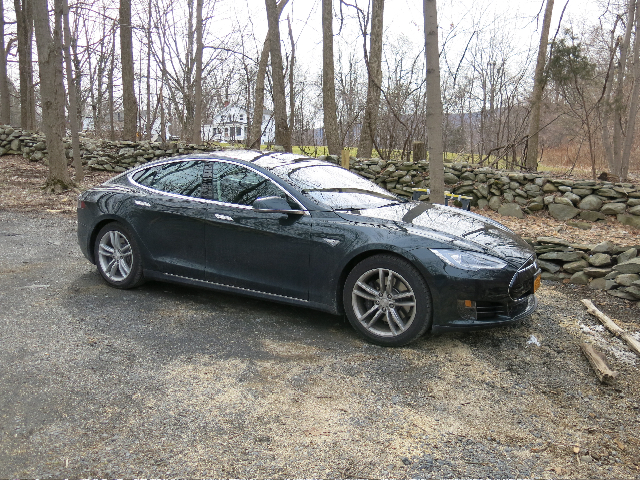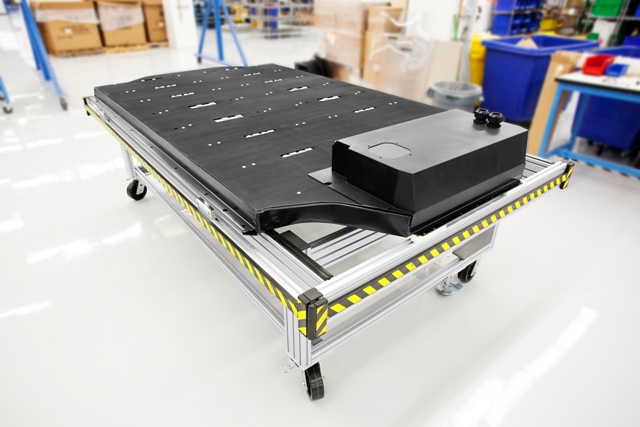
So far, the New York-to-Florida electric-car road trip in my 2013 Tesla Model S is progressing pretty much according to plan.
That's not to say I haven't learned a few things in traveling via the newly-completed network of Tesla Supercharger DC quick-charging stations.
One of them would be that cold weather really does cut the range of electric cars--to the point where even with my new 85-kWh battery pack, I just squeaked into one Supercharger station with a handful of miles left.
But let's start at the beginning ....
DAY 1: Hudson Valley, New York, to Newark, Delaware
I left at 3 pm, after a brunch to meet my teen-age daughter's new boyfriend. (Very important occasion.) Shooting to make the Supercharger in Newark, Delaware, shortly after dark. It's about 175 miles from my home in New York's Hudson Valley.

Tesla Supercharger fast-charging system for electric cars
The temperature at departure is 16 degrees. I charge to 90 percent in the morning; the plan is to top off the last 10 percent just before departure. This warms the battery a bit and reduces the huge initial energy suck from a stone-cold start.
I get impatient, however, with the very slow charge rate when the battery is nearly full,and drive off with about 95 percent, with the rated range showing 251 miles. Should be more than enough, even driving fast in the cold.
The topping-off process proves only partially effective; the "Battery Heating" indicator still comes on after a few minutes, and the regen braking is limited initially--as it normally is in cold weather. Just not as much.
Energy consumption is ferocious for the first 20 or 30 miles, hitting more than 600 Wh per mile--about double the normal consumption. The first 20 miles of driving eat up 40 miles of rated range; I'm already down to 210.
At 30 miles, on New Jersey Route 17, I give a friendly wave as I pass Ramsey Nissan, who back in November kindly let me use their Level 2 charging station the last time I drove to Newark. That was when I had a 60-kWh battery; I've since upgraded to an 85-kWh pack. This trip will be the first real range test for the new battery.
I cruise at my normal 70-75 mph, with the heat set at 72 degrees. As I drive, I keep careful track of how the range display compares with the actual miles driven. I'm shocked to find that, even after everything is fully warmed up and energy consumption has stabilized at about 370 kWh/mi, for every 10 miles of indicated range lost, I'm only driving about 7 actual miles.
Tesla Motors - Model S lithium-ion battery pack
After 60 actual miles--with 115 left to go--I'm showing a rated range of 150 miles remaining. But discount those miles by 30 percent, and the actual range remaining is....105 miles. Holy Moses. At this rate, I may not make it.
I slow to 65 mph and turn the heat down to 65 degrees. By this time, the outside temperature has climbed to about 25 degrees. With all these factors, the rated-range discrepancy is now running at only about 10 percent, suggesting an actual range remaining of 135 miles. Phew.
By constantly calibrating the two numbers--rated and actual range--I'm gradually able to increase the speed and cabin temperature slightly as I get closer to Newark. I pull in with 18 miles of indicated range remaining, triggering a low-battery warning and a cutback the available maximum power.
While I'm plugging in, a local Tesla rep drives up with a potential customer in tow on a demo drive. When I mention I'm heading for Florida, he says he's not aware of anyone doing that yet.
The tire-kicker quizzes me about the Supercharging. When I tell him the electricity is free, he is totally dumbfounded. (My bet is the guy will buy the car.)
I have a quick fast-food dinner at the Newark service area food court while the car charges, then drive to a nearby motel with 217 miles of range indicated. My plan is to return the next morning to repeat the topping-off process.
After today's sobering dose of reality--cold weather is truly more of a range-killer than I had expected--I'm going to need every kilowatt-hour tomorrow morning. The next leg, to the Supercharger in Glen Allen, Virginia, is 199 miles.
[EDITOR'S NOTE: Due to technical glitches, our author wasn't able to take photos during his second day on the road. But as many readers will already know, the picture above is the car he's using, along with his dog--who seems to photo-bomb most of Noland's photos...]
- Miles: 176.4
- Kilowatt-hours: 64.8
- Average: 368 watt-hours/mile
- Cushion: 19 mi
DAY 2: Newark, Delaware, to Santee, South Carolina
NEWARK, DE, to GLEN ALLEN, VA
After topping off during breakfast, I depart with a 99-percent-full battery. (That last 1 percent would have been agonizingly slow.) Temperature is 26 degrees.
2013 Tesla Model S in winter, Hudson Valley, NY [photo: David Noland]![2013 Tesla Model S in winter, Hudson Valley, NY [photo: David Noland] 2013 Tesla Model S in winter, Hudson Valley, NY [photo: David Noland]](https://images.hgmsites.net/lrg/2013-tesla-model-s-in-winter-hudson-valley-ny-photo-david-noland_100454456_l.jpg)
I start off on I-95 with the cruise control set at 69 mph and the cabin temp at 69 degrees. With the warmer weather and longer top-off, the initial energy suck is much smaller.After peaking over 600 kWh/mi, the consumption falls to 400 within a few minutes.
As the temperature quickly warms into the 30s, and then 40s, the consumption settles in at about 320 wH/mi. Rated range miles are matching actual miles almost precisely.
Efficiency is helped by my choice of routes around Washington D.C. Instead of I-95, I take Maryland State Road 301, which runs south from Annapolis to Richmond east of I-95. Traffic runs a bit slower, and there are a few stoplights. The lower average speed helps my efficiency.
I pull in to the Glen Allen Supercharger with a fat cushion of 29 miles. (This despite missing an exit and an unplanned detour of 8 miles.) When I step out of the car, the sun is shining and the temperature is 60 degrees.
Polar Vortex, eat my dust!
- Miles: 207.5
- kWh: 66.0
- Avg: 318 wH/mi
- Cushion: 29 mi
GLEN ALLEN, VA, to ROCKY MOUNT, NC
After lunch at a nearby Chili's, I depart with about an 80-percent charge, giving me 227 miles of indicated range. The next three legs, to Superchargers in Rocky Mount and Lumberton in North Carolina, and Santee, South Carolina, are short: only 132, 120, and 123 miles respectively.
These short legs allow Model S drivers to take advantage of the fact that Superchargers charge much faster--up to 120 kW--when the battery is depleted. That's enough to add about 360 miles of range for every hour of charging.
The clever charging strategy for these short legs, then, is to arrive as empty as possible, and recharge up to about half full in as little as 20 minutes. Then head to the next Supercharger with just enough juice to get there.
Because I ate lunch at the Chili's next to the Glen Allen Supercharger, I actually charged longer than I needed to. Departing with 80-percent charge and 227 miles of range, Glen Allen to Rocky Mount was a breeze: 75-77 mph, with the outside temp at a sunny 63 degrees.
Finding the Superchargers is not proving to be a problem; the GPS map in the car highlights them automatically. Lacking the pricey optional tech package, I don't have turn-by-turn directions on my GPS, but there it is on the screen--easy as pie to find and navigate to.
- Miles: 132.4
- kWh: 45.0
- Avg: 340wH/mi
- Cushion: 66 miles
ROCKY MOUNT, NC, to LUMBERTON, NC
With a fat cushion of 66 miles, I spent only about 20 minutes at Rocky Mount, enough to add 107 miles. That brings my total range for the 120-mile leg to Lumberton to 173 miles. Again, a smooth, effortless 75-mph run.
2013 Tesla Model S in winter, Hudson Valley, NY [photo: David Noland]![2013 Tesla Model S in winter, Hudson Valley, NY [photo: David Noland] 2013 Tesla Model S in winter, Hudson Valley, NY [photo: David Noland]](https://images.hgmsites.net/lrg/2013-tesla-model-s-in-winter-hudson-valley-ny-photo-david-noland_100454455_l.jpg)
The road was punctuated by flashing signs warning me to watch for trucks engaged in anti-icing activity. Skies were clear and temperature was 68 degrees at the time. Apparently, South Carolinians have a bit to learn about anti-icing activity.
But the average consumption, at 357 wH/mi, was higher than I expected, and I arrived with only a 20-mile cushion. Perhaps the route was a bit uphill.
Moral: when charging, always add a few miles for the unexpected.
- Miles: 120.4
- kWh: 43.0
- Avg: 357 wH/mi
- Cushion: 20 mi
LUMBERTON, NC, to SANTEE, SC
Another quick charge in Lumberton, enough to bring the indicated range up to 169 miles for the 123-mile leg to Santee. And another fast, effortless 75-mph run, this one partly in the dark. It's the first highway test of my dazzling new HID headlights, which I upgraded along with the battery.
One word: Awesome.
The Santee Supercharger, located in the parking lot of a classic local inn and restaurant, is ideal for an overnight stop. As I'm leaving the restaurant to head for bed, I hear talk of freezing rain and serious snow tomorrow. No, not back in New York--here, in Santee.
The Polar Vortex is taking its revenge.
- MILES: 123.5
- kWh: 42.6
- Avg: 345 wH/mi
- Cushion: 18 mi
Overall, Day 2 was a good day: 584 miles, and a total of only about two hours total charging time.
These last three short runs show the full potential of the Supercharger network when spaced about 120 miles apart. You can drive as fast as you want, in any weather, and not spend more than half an hour charging. It's truly a paradigm shift in the way we drive.
When the Supercharger network is completed, with Superchargers 120 to 150 miles apart, no other car will even come close to the Model S.
But I wonder how it handles freezing rain? I may find out.
_______________________________________________
Follow GreenCarReports on Facebook, Twitter, and Google+.












